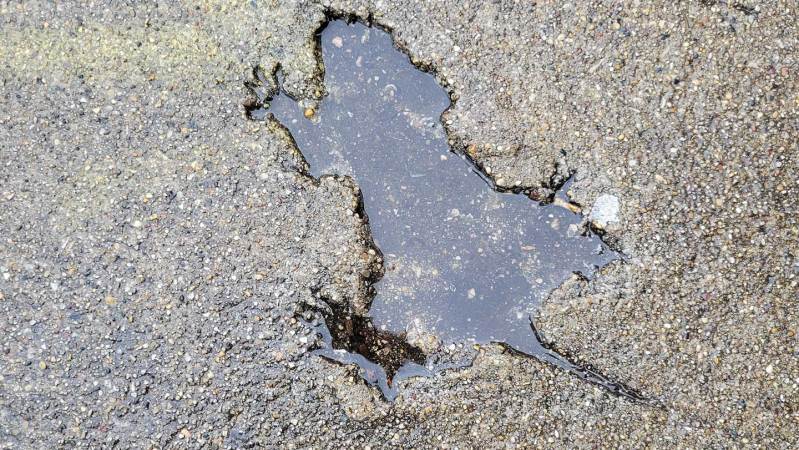Science
Chicago’s Viral ‘Rat Hole’ Likely Created by Squirrel, Study Reveals

The viral phenomenon known as the Chicago “Rat Hole” is not what many believed. According to a recent study published on October 15, 2024, researchers have determined that the peculiar concrete imprint, which captivated social media users, was likely made by a squirrel rather than a rat. This finding comes from an investigation led by Michael Granatosky, an evolutionary biomechanics researcher at the University of Tennessee in Knoxville.
The “Rat Hole,” affectionately dubbed “Splatatouille” by artist Winslow Dumaine, gained notoriety in 2024 after Dumaine shared images online. It quickly became a cultural touchstone in the Roscoe Village neighborhood, with visitors leaving coins, flowers, and other tokens at the site before it was relocated to City Hall. The fascination surrounding the hole prompted Granatosky and his team to apply scientific methods to this lighthearted mystery.
Scientific Investigation into the Mystery
Utilizing paleontological tools, the researchers analyzed the imprint and collected numerous images submitted by the public. They measured anatomical features such as snout-to-tail length and head width from the photos. By employing the app iNaturalist, the team identified eight small mammal species that inhabit Chicago, including the eastern gray squirrel (Sciurus carolinensis) and the fox squirrel (S. niger).
Granatosky noted that the measurements taken from the imprint closely matched those of these squirrel species. He proposed that the hole was likely created when a squirrel fell from a tree, which was reportedly located near the site prior to its removal. Granatosky explained that for a rat to leave a similar impression, it would have had to be dropped from a height, as no footprints were found in the surrounding concrete.
Despite the compelling evidence, Granatosky acknowledged the challenges of making a definitive identification. He stated, “Even with all the information the team had, it still wasn’t able to make a definitive identification from this relatively recent critter crater.” This situation underscores the complexities faced by paleontologists when analyzing both ancient and modern specimens.
Encouraging Curiosity and Education
Granatosky hopes that this study will spark further debate among colleagues and ignite public interest in science. He is currently developing educational materials aimed at children, emphasizing the importance of observation and inquiry. “It’s so rare to get such a fun story,” he remarked, adding that it reflects the core mission of his lab—taking data and making it accessible to a broader audience.
As “Splatatouille” continues to capture the imagination of the public, this investigation serves as a reminder of the joy that can be found in scientific exploration, even in the most unexpected places. The blend of curiosity, humor, and rigorous research has transformed a local curiosity into an educational opportunity, showcasing the intersection of science and community engagement.
-

 Politics1 week ago
Politics1 week agoDallin H. Oaks Assumes Leadership of Latter-day Saints Church
-

 Sports1 week ago
Sports1 week agoSteve Kerr Supports Jonathan Kuminga After Ejection in Preseason Game
-

 Lifestyle1 week ago
Lifestyle1 week agoDua Lipa Celebrates Passing GCSE Spanish During World Tour
-

 Business1 week ago
Business1 week agoTyler Technologies Set to Reveal Q3 2025 Earnings on October 22
-

 World1 week ago
World1 week agoD’Angelo, Iconic R&B Singer, Dies at 51 After Cancer Battle
-

 Entertainment1 week ago
Entertainment1 week agoZoe Saldana Advocates for James Cameron’s Avatar Documentary
-

 Lifestyle1 week ago
Lifestyle1 week agoKelsea Ballerini Launches ‘Burn the Baggage’ Candle with Ranger Station
-

 Health1 week ago
Health1 week agoRichard Feldman Urges Ban on Menthol in Cigarettes and Vapes
-

 Health1 week ago
Health1 week agoCommunity Unites for Seventh Annual Mental Health Awareness Walk
-

 Business1 week ago
Business1 week agoMega Millions Jackpot Reaches $600 Million Ahead of Drawings
-

 Sports1 week ago
Sports1 week agoPatriots Dominate Picks as Raiders Fall in Season Opener
-

 Business1 week ago
Business1 week agoMLB Qualifying Offer Jumps to $22.02 Million for 2024










